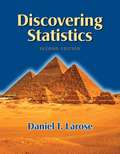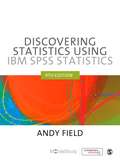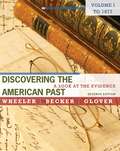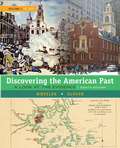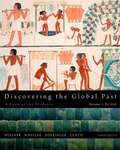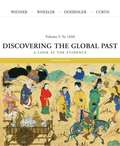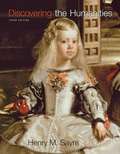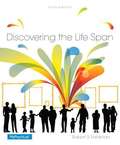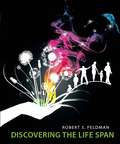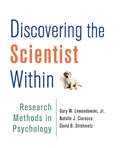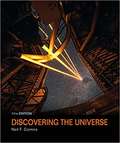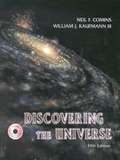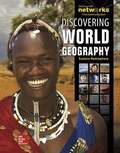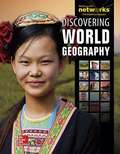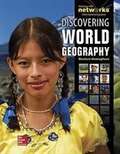- Table View
- List View
Discovering Statistics (2nd Edition)
by James S. Hawkes William H. MarshThe text includes many new real-world problems, very colorful graphics, interesting sidebars, additional topics, and a new chapter on Statistical Process Control.
Discovering Statistics (2nd Edition)
by Daniel T. LaroseDiscovering Statistics is intended for an algebra-based, undergraduate, one- or two-semester course in general introductory statistics for non-majors. It will prepare you to work with data in fields such as psychology, business, nursing, education, and liberal arts, to name a few.
Discovering Statistics using IBM SPSS Statistics
by Andy FieldUnrivalled in the way it makes the teaching of statistics compelling and accessible to even the most anxious of students, the only statistics textbook you and your students will ever need just got better!<P><P> Andy Field's bestselling Discovering Statistics Using SPSS 4th Edition, already an immensely comprehensive textbook - taking students from first principles to advanced statistical concepts, and all the while grounding knowledge through the use of SPSS - now focuses on providing essential updates, better accessibility to its key features, more instructor resources and broader reach to new student groups - with powerful new digital developments on the textbook's companion website.<P> New to the 4th Edition<P> - New WebAssign® facility. If you adopt this for use on your course it will allow you to produce and manage assignments online with your students and includes a grading facility to monitor students' progress. Students can practise questions over and over and be provided with instant feedback and links to the accompanying Ebook where correct solutions can be found<P> - The mobile study facility encourages students equipped with smartphones and tablets to access revision material such as Cramming Sam's Study tips helping them to study when it suits them. QR codes in the textbook provide instant access<P> - Education and Sport Sciences instructor support materials with enhanced ones for Psychology, Business and Management and the Health sciences make the book even more relevant to a wider range of subjects across the social sciences and where statistics is taught to a cross-disciplinary audience.<P> Major Updates to the 4th Edition<P> - Fully compatible with recent SPSS releases up to and including version 21<P> - Exciting new characters. Statistical cult leader Oditi provides students with access to video clips to help further understanding of statistical/SPSS concepts, while Confusious helps students to make better sense of statistical terms<P> - An enhanced Companion Website offers plenty of lecturer and student material to use in conjunction with the textbook. These include PowerPoints and Testbanks for lecturers as well as answers to the Smart Alex tasks at the end of the each chapter; datafiles for testing problems in SPSS; flashcards of key concepts; self-assessment multiple-choice questions; and online videos of key statistical and SPSS procedures discussed in the textbook for students.
Discovering the American Past: To 1877
by William Bruce Wheeler Susan D. Becker Lorri GloverThis primary source reader in the popular DISCOVERING series contains a six-part pedagogical framework that guides readers through the process of historical inquiry and explanation. The text emphasizes historical study as interpretation rather than memorization of data. Each chapter is organized around the same pedagogical framework: The Problem, Background, The Method, The Evidence, Questions to Consider, and Epilogue. The Seventh Edition integrates new documents and revised coverage throughout. For example, the Reconstruction chapter, appearing in Volumes I and II, now explores Thomas Nast's political cartoons and their effect on public opinion.
Discovering the American Past: To 1877
by William Bruce Wheeler Lorri GloverThis primary source reader in the popular DISCOVERING series contains a six-part pedagogical framework that guides students through the process of historical inquiry and explanation. The text emphasizes historical study as interpretation rather than memorization of data. Each chapter is organized around the same pedagogical framework: The Problem, Background, The Method, The Evidence, Questions to Consider, and Epilogue. Volume I of the Eighth Edition integrates new documents and revised coverage throughout. For example, there are new chapters on creation stories and culture in colonial America, the transition to racial slavery in Virginia, women's rights, and Civil War nurses.
Discovering the Global Past: A Look at the Evidence, Volume I: To 1650
by Merry E. Wiesner William Bruce Wheeler Franklin M. Doeringer Kenneth R. CurtisNIMAC-sourced textbook
Discovering the Global Past, Volume 1: To 1650 (3rd edition)
by Merry E. Wiesner Kenneth R. Curtis Franklin M. Doeringer William Bruce WheelerThis successful world history version of the popular Discovering series contains a multi-part pedagogical framework that guides students through the process of historical inquiry and explanation. The text emphasizes historical study as interpretation rather than memorization of data. The Third Edition integrates new documents and revised coverage throughout, while the comparative chapters contribute to a more thorough and balanced examination of global history. Each chapter is organized within the same pedagogical framework: The Problem, Background, The Method, The Evidence, Questions to Consider, and Epilogue.
Discovering the Humanities (3rd Edition)
by Henry M. SayreFor courses in Introduction to the Humanities See context and make connections across the humanities Throughout Discovering the Humanities, Third Edition, author Henry Sayre employs a storytelling approach that helps students see context and make connections across the humanities. Believing that people learn best by remembering stories rather than memorizing facts, Sayre weaves a compelling narrative of multifaceted cultural experiences that will resonate with students -- throughout the course and beyond. By showing how cultures influence one another, and how ideas are exchanged and evolve over time, Discovering the Humanities helps students understand the cultural interplay that has shaped human thinking and creativity throughout our history. Also available with MyArtsLab#65533; MyArtsLab for the Introduction to Humanities course extends learning online, engaging students and improving results. Media resources with assignments bring concepts to life, and offer students opportunities to practice applying what they've learned. And the Writing Space helps educators develop and assess concept mastery and critical thinking through writing, quickly and easily. Please note: this version of MyArtsLab does not include an eText. Discovering the Humanities, Third Edition is also available via REVEL(tm), an immersive learning experience designed for the way today's students read, think, and learn.
Discovering the Life Span
by Robert S. FeldmanDiscovering the Life Span, 3/e by Robert S. Feldman helps students truly connect to the material. Written in an engaging and accessible style and organized in a modular format, this title allows instructors to cover the entire lifespan without having to sacrifice content throughout their course. Students will get a better sense of the entire process of development and understand how the domains of development work together. Discovering the Life Span is a meaningful learning experience that prepares readers to apply content to their personal and future professional lives.
Discovering the Life Span
by Robert S. FeldmanModular, manageable, meaningful--help your students discover the life span! Based on extensive market research, and informed by author Robert Feldman's own teaching experience, Discovering the Life Span was created to meet key teaching needs. Many instructors would like to cover the entire life span in a single term. They would like their students to see the big picture and understand how the domains of development work together. And, perhaps most importantly, they would like their students to truly connect to the material. This remarkable first edition does all three of these things. Here's how: Structured around a modular format, each stage of life and each domain are treated equally throughout the text. This balanced format offers instructors teaching flexibility while helping students see the connections between the physical, cognitive, and social/personality domains.
Discovering the Scientist Within Research Methods in Psychology
by Gary W. Lewandowski Natalie J. Ciarocco David B. StrohmetzIn this breakthrough first edition, authors Gary Lewandowski, Natalie Ciarocco, and David Strohmetz draw on their extensive classroom experiences to introduce research methodology in a highly effective, thoroughly engaging new way, maximizing students’ familiarity with every step of the process. For the first time in a methods text, each design chapter follows a single study from ideation to writing for publication, with students researching an intriguing question emerging from a chapter-long case study. Also for the first time in a methods text, each design chapter models the entire research process, so students get multiple opportunities to experience that process start to finish.
Discovering the Universe
by Neil CominsCombining a student-centered approach with the reliability of a familiar and proven text, Discovering The Universe invites students to follow their curiosity and ask questions about astronomy, through features including What If? questions that explore alternative solar systems and universes and Meet the Discoverer interviews with working scientists throughout the text.
Discovering The Universe (Fifth edition)
by William J. Kaufmann Neil F. CominsA scientific theory can be independently tested and potentially disproved. Newton's ideas can be tested and potentially disproved by observations and thus qualify as scientific theory. The idea that God created the Earth in six days cannot be tested, much less disproved. It is not a scientific theory but rather a matter of faith.
Discovering World Geography: Eastern Hemisphere (Oklahoma)
by Richard G. BoehmNIMAC-sourced textbook
Discovering World Geography: Eastern Hemisphere
by Richard G. Boehm Jay Mctighe Dinah ZikeNIMAC-sourced textbook
Discovering World Geography: Western Hemisphere
by Richard G. Boehm Jay McTighe Dinah ZikeNIMAC-sourced textbook <p><p> Focus on the big ideas with an accessible print student text built around Essential Questions, enduring ideas, and Oklahoma Standards. Puts students in the middle of the action with The Story Matters chapter openers, Biography features, maps, and timelines. The Reading Help Desk in each lesson assist students with reading strategies, note-taking activities, graphic organizers, and vocabulary support. Features such as Thinking Like a Historian, It Matters Because, What Do You Think, and Connections to Today help build critical thinking and historical analysis skills.
Discovering World Geography: Eastern Hemisphere with World History
by Mcgraw-Hill EducationNIMAC-sourced textbook
Discovering World Geography: Western Hemisphere
by Mcgraw-Hill StaffConnect to core World Geography content with an accessible, student-friendly text built on the principles of Understanding by Design.

